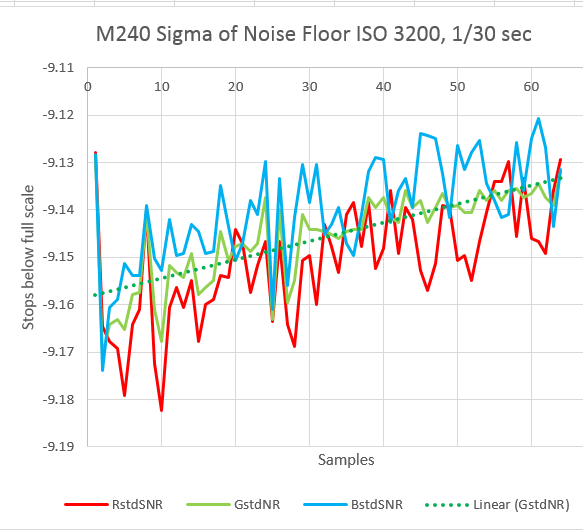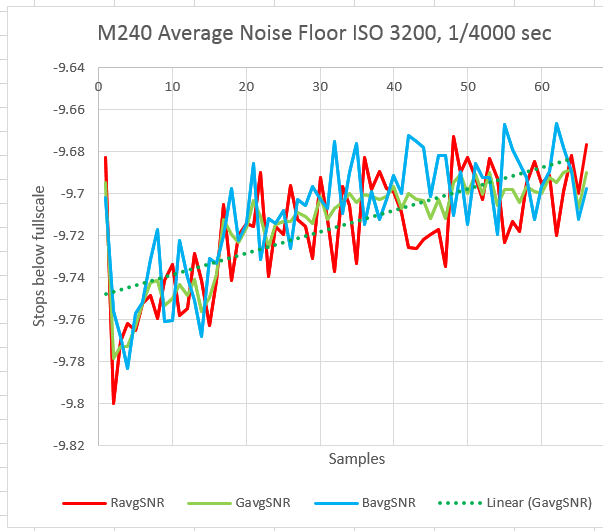In the next few posts, I’m going to characterize the Leica M (Typ 240), hereafter called the Leica M240, or just the M240. The first thing I do when I characterize a camera is see if there are self-heating effects that I need to watch out for. If there are, it makes the testing process a real drag, since I have to wait between test exposures. Fortunately, these effect have not usually been material with the cameras that I’ve tested so far. However, I can’t count of that, so here’s how I test.
I make a series of exposures of the back of the lens cap with the aperture set to the physically smallest opening, the ISO at maximum (not counting the “push” settings, and the shutter speed at 1/4 second (if there’s no long-exposure noise reduction at that setting). The file format was DNG with no compression. In the case of cameras with buffers of a dozen pictures or so like the M240, I make the exposures as fast as the camera can go. I used a Lexar 128 GB 400x (10) SD card, which gave be a sustained rate of about a picture every 3 seconds or so.
Here’s the average noise floor over 64 exposures. I’ve plotted the red and blue channels, and the average of the two green channels over a rectangle that includes the central 90% of the pixels.
Self heating is evident, but at a very low level. The trend line change from the beginning to the end of the series is less that .04 stops.
Plotting the standard deviation produces similar results:
While probably not a problem, this is the strongest and most consistant self-heating effect that I’ve observed, so I repeated the results at 1/30 of a second.
The average noise:
and the standard deviation:
Not much difference.
For completeness, I looked at 1/4000 second exposures. First, the averages:
And next, the standard deviations:
Again, not much difference.
There’s one strange thing in common across all these series; the first exposure has more noise than the next few. What’s that all about? I’ve no idea.
At ISO 200, you can observe the noise floor being quantized by the precision of RawDigger’s resolution, which is 0.01 LSB:
The noise at ISO 200 is a full two stops under the Nikon D4’s noise at ISO 100 under the same conditions. It may be that Leica and Nikon apply different offsets.
The standard deviation shows two anomalies in the blue channel:
Looking at the histogram of the noise floor at ISO 3200 at 1/30th, we see normal behavior, with no evidence of red and blue channel prescaling (note that the horizontal axis is linear and the vertical axis is logarithmic):
The histogram at ISO 200 and 1/30 is a more dispositive test for prescaling, and the lack of gaps in the meat of the red and blue histograms indicates that there is none:
The positive second derivative (holds water) of the ISO 200 histograms in the first ten buckets is unusual, and may be evidence of a negative offset applied to the signals prior to the ADC. If true, this would explain the surprisingly low ISO 200 noise floor.










Leave a Reply